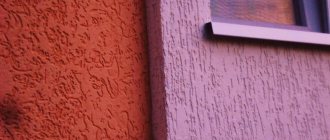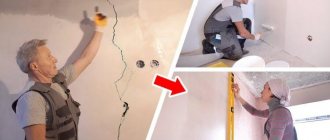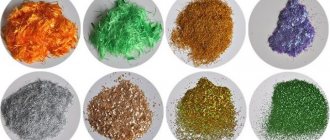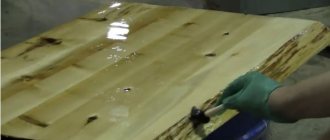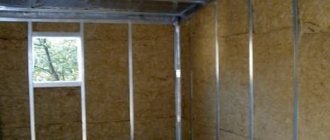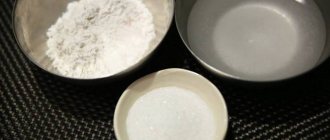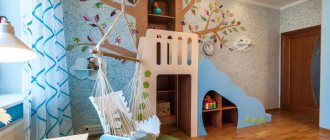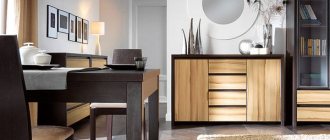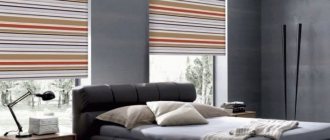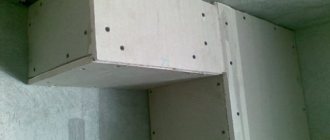Paper wallpaper in the interior of an apartment
Wallpapering is one of the most popular methods of decorative wall decoration today. This is an opportunity to quickly and inexpensively change the interior of your home and give it a unique flavor. On the modern market of finishing materials there are various types of wallpaper for walls. The most affordable of them is paper wallpaper. Today this is the simplest and most profitable finishing option based on the “price-quality” criterion.
Advantages of paper wallpaper
The popularity of paper wallpaper is due to a number of its advantages.
Decorating walls with wallpaper is one of the safest types of decoration for the human body. Paper wallpaper, like its glue, does not contain harmful substances and is an absolutely environmentally friendly material. They allow air to pass through and create a healthy microclimate in the room.
It is not difficult to wallpaper the surface of the walls yourself. Therefore, the simplicity of finishing is another plus in favor of this finishing option.
Low cost is also a very attractive factor for consumers.
A variety of patterns, colors and textures allows you to decorate the interior in any style.
Considering all the advantages of paper wallpaper, they are in great demand when decorating the interior of residential premises.
Varieties
The following types of paper wallpaper are distinguished.
- Simplex, or single-layer wallpaper, is a single layer of paper with a pattern applied on one side by intaglio or flexographic printing using water-dispersion inks. Their main advantage is their low price. In addition, such wallpaper can be glued using any wallpaper glue. A surface decorated with such material is capable of permeating air, that is, “breathing.” Disadvantages of simplex: instability to moisture and sunlight (in the latter case they quickly fade), short service life (with proper care they will last no more than 5 years). Their area of application is dry living rooms.
- Duplex is a more durable and wear-resistant material, since it consists of two or more paper sheets interconnected. The advantages of such a coating include high sound and heat insulation. In the process of its creation, higher quality paints are used. In addition, a full-color pattern is applied to such material, which is given additional volume by embossing. As a result, such paper wallpaper will last much longer. The high strength of this coating makes it easy to work with. They are denser than single-layer wallpaper, so they mask small defects in walls and ceilings. This material has an additional layer that protects the surface of the wallpaper from external negative factors. Duplex wallpaper does not fade in the sun.
- Laminated is a subtype of two-layer wallpaper that is embossed in a register. After gluing two paper sheets (one of them has a pattern on it), they are embossed. This material has a luxurious relief that becomes a repetition of the applied pattern. Laminated wallpaper is a real decoration for any interior; it looks original and elegant.
- Foam wallpaper is a coating whose production is similar to the production of duplex. Paper sheets glued together are spot-treated with acrylic polymers and then subjected to high-temperature exposure. Thus, a relief pattern is formed on the front side of the wallpaper. This coating is wear- and moisture-resistant. These paper wallpapers for walls have many designs. Their texture helps hide surface defects. Air exchange when covering walls is not disturbed.
Selection of colors and patterns
When planning the interior of a room, it’s a good idea to take into account the basic rules for selecting wallpaper for a room.
Light wallpaper in pastel shades helps to visually increase the area of the room. For this reason, they should be purchased for a small room. For a large room, dark colors are also suitable.
Wallpaper in warm colors will serve as the best option for decorating dark rooms; they will help add light. A well-lit room on the sunny side can also be decorated in cool colors.
A large drawing will organically fit into a spacious interior. For a small space, wallpaper with a small pattern would be a smart decorative option.
When choosing, it is important to consider the style of interior design. The color and pattern of the wall covering must correspond to the general style direction.
When choosing, it is important to take into account the consumer characteristics of the material, their strength and texture.
In addition, all rolls must be from the same batch so that there are no differences in shades. The packaging must be intact, without damage, indicating the manufacturer’s details.
To decide on the decor option for your living space, you can look at photos of paper wallpaper in various interior design options.
Wallpaper for painting
Paper duplex wallpaper is indispensable for choosing wallpaper for painting.
Such wallpapers are distinguished by a pronounced embossed texture of the pattern; the color of the wallpaper is usually white.
The outer layer with texture has a sufficient margin of safety for repeated (up to 10 times) coating with paint; such wallpaper is divided into three main types: coarse fibrous, structural, and moisture resistant.
They are produced by hot stamping using wood shavings between the layers.
Preparing the walls
All wall surfaces in the room must be freed from previous wallpaper by thoroughly wetting them. It is convenient to use a paint brush for this.
If the walls were pre-painted, then the paint layer must also be removed. Old oil paint can be cleaned with a spatula; the water-based paint must first be soaked in a soap solution.
If the surface of the walls is covered with DPV slabs, then it is necessary to fill the seams between the slabs with a building mixture. The nail heads also need to be hidden under a layer of putty or paint, otherwise rust stains may appear on the wallpaper over time.
After cleaning, the walls should be examined for cracks and peeling plaster. The cracks must be covered, the plaster must be removed and the area must be re-plastered.
The surface of the walls must be leveled and impregnated with a primer. Various elements need to be removed from the walls: door casing, sockets and switches.
For further work you need to prepare:
- roulette,
- knife,
- clean brush (or a roller),
- a clean container for dissolving glue,
- dry and clean cloth or foam sponge.
Marking and cutting
Before gluing paper wallpaper, you need to measure the height of the room. Measurements from floor to wall to ceiling should be taken in different places. The largest indicator is taken as the basis for cutting.
The rolls are inspected and unpacked.
It is convenient to cut the material using a sharp knife with a wide and long blade. Before cutting, it is important to correctly adjust the design. The alignment is done on the floor with the material face up.
The strips are adjusted according to the design, measured and cut. It is more convenient to adjust the design by rolling out two rolls at once.
On some packages, the manufacturer already indicates the reserve for selecting a pattern. Usually it is 6-10 cm. An exception would be wallpaper with a very large pattern.
Applying glue
To work, you need special wallpaper glue. Wallpaper glue is mixed with water according to the recommendations on the package.
The adhesive composition is evenly distributed over the back side of the wallpaper using a roller or brush. It is important to coat the entire surface, paying special attention to the edge.
The surface of the walls can also be covered with glue.
The material must be saturated with glue to avoid bubbles.
Single layer wallpaper
At the dawn of its appearance, there were simple single-layer double-sided wallpapers, where the front side was with a pattern and the back was for sticking on the wall.
This is the thinnest and most short-lived wallpaper; to stick it, you need to carefully prepare the wall (the surface to be glued), since all the unevenness of the wall surface shows through the thin layer of wallpaper.
Pasting walls
It is more convenient to start work from the window opening. It is important to immediately decide whether the strips will overlap each other to form seams.
When gluing end-to-end, work can begin from any corner of the room.
A strip soaked in glue is carefully applied to the surface of the wall, starting from the top.
This is a very important stage. The strip must be aligned vertically.
Glue from the ceiling, carefully smoothing the surface with a rag.
The excess remaining near the floor surface is cut off after the sheet has dried.
It is more convenient to smooth the seams with a rubber roller; the overlap should be minimal.
Excess adhesive mass is carefully removed with a sponge or clean cloth. It is more convenient to smooth a textured surface using wet movements. You should also do this if the wallpaper is too wet from the glue. This will help avoid surface damage.
Pasting difficult places
The placement of switches, electrical sockets, shaped arches and niches are considered difficult.
Electricity should be turned off.
The place where the socket is located is covered with a whole strip, and then a hole is carefully cut out for it.
Complex interior elements can be measured and a piece of wallpaper can be cut out, taking into account their configuration and a small margin, so as not to then cut off from the pasted part.
The outer corner is designed by measuring the distance from the previous glued sheet to the corner with a small margin. It is wise to cut off the excess immediately. The next strip is glued with a slight overlap on the corner.
The inner corner is covered with an overlap, and the next sheet is aligned along the corner.
Uneven corners and wall surfaces can make work difficult.
In general, covering a room with paper-based wallpaper is not difficult without prior experience.
Paper wallpaper is an excellent way to decorate a living space. They are easy to use, do not require major expenses and the involvement of specialists. This is a material that is safe for health and allows you to implement any interior design ideas.
When deciding whether it is possible to glue paper wallpaper in a particular room, it is important to pay attention to their technical characteristics. The duplex option or vinyl-coated wallpaper are appropriate in the kitchen and even in the bathroom.
Three-layer wallpaper
In fact, this is a reinforced version of multi-layer wallpaper, its main purpose is to increase its service life (10-15 years).
They consist of three layers, similar to two-layer ones, glued together, where the third layer provides additional strength.
They are more rigid, fix well and stay on the wall for a long time, hide minor irregularities on the surface of the coating.
